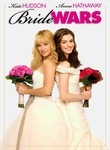 Bride Wars.
Bride Wars.(Yeah, I watched it. So what.)
Before I begin, let me say the following: It was not my intention to watch Bride Wars. I don't consider it to be a good movie. But I watched it anyway. Why?
Because I believe it worked successfully as a movie . What do I mean by "worked successfully"? Well, look at the numbers. There's a reason why it grossed over $115 million worldwide and it only cost $30 million to produce. I explain below with my top three reasons of "Why this film works."
1) Clear Title: Bride Wars. By reading the title we know what the entire movie is about. We don't know why the brides battle, but we know they battle and we're immediately enticed to find out. Not to mention, the word "Bride" generally attracts the female demographic, while "War" attracts the male demographic.
"Ok, you have my attention..."
2) Wedding Theme: Again, the definitive title is also suggestive of the theme - weddings. People are always getting married, which means that a very large consumer demographic can relate (in one way or another) to the notion of a wedding. Don't believe me? Think about the success of these films: My Best Friend's Wedding, My Big Fat Greek Wedding, or even Wedding Crashers. Weddings are popular. Weddings attract an audience. And people will always pay to watch stories about weddings.
Now that the title has hooked us, what keeps us watching?
3) Structure: The story, though predictable, follows a structure well suited for the story, as two, life-long best friends are pitted against one another on their shared wedding days.
The structure (as diagrammed below) demonstrates how these two best friends (A and B) actually grow closer as they progress through their individual Bride War experiences.

Act 1 defines the pre-existing relationship. Life is perfect. However, this movie isn't worth watching unless we have a conflict, which is what the vertical line symbolizes. The perfect-world fantasy is over - both parties have hit a brick wall and will venture in separate directions.
Act 2 explores the "War." What will these characters do to get a leg up over the competition? As the conflict escalates the plot thickens. Stakes are raised and vicious truths are revealed. A simple question is asked, "Would my best friend really do this to me?"
Act 3 finds resolution. They've been best friends and they're meant to remain best friends. Once they set their differences aside they'll find themselves closer than they were before. Resolution.
Combine these three examples of "Why this film works" with the star power of Kate Hudson, Anne Hathaway, and Candace Bergen and you have a basic recipe for success (relatively speaking). But this is only a small portion of making movies. There are still countless variables (writing, directing, production value) that require professional attention in order to help contribute to this films' success.
As I said, these are my top three arguments for how and why this film worked. I liked the simple structure, but I wasn't keen on the story.
Author's Note:
If you're interested in screen writing - watch movies. The more movies you watch, the more you'll understand story structure. You'll come to understand the structures you like and the structures you don't like. As your taste for movies becomes more distinguished, write (authentically) to match your structure.















No comments:
Post a Comment